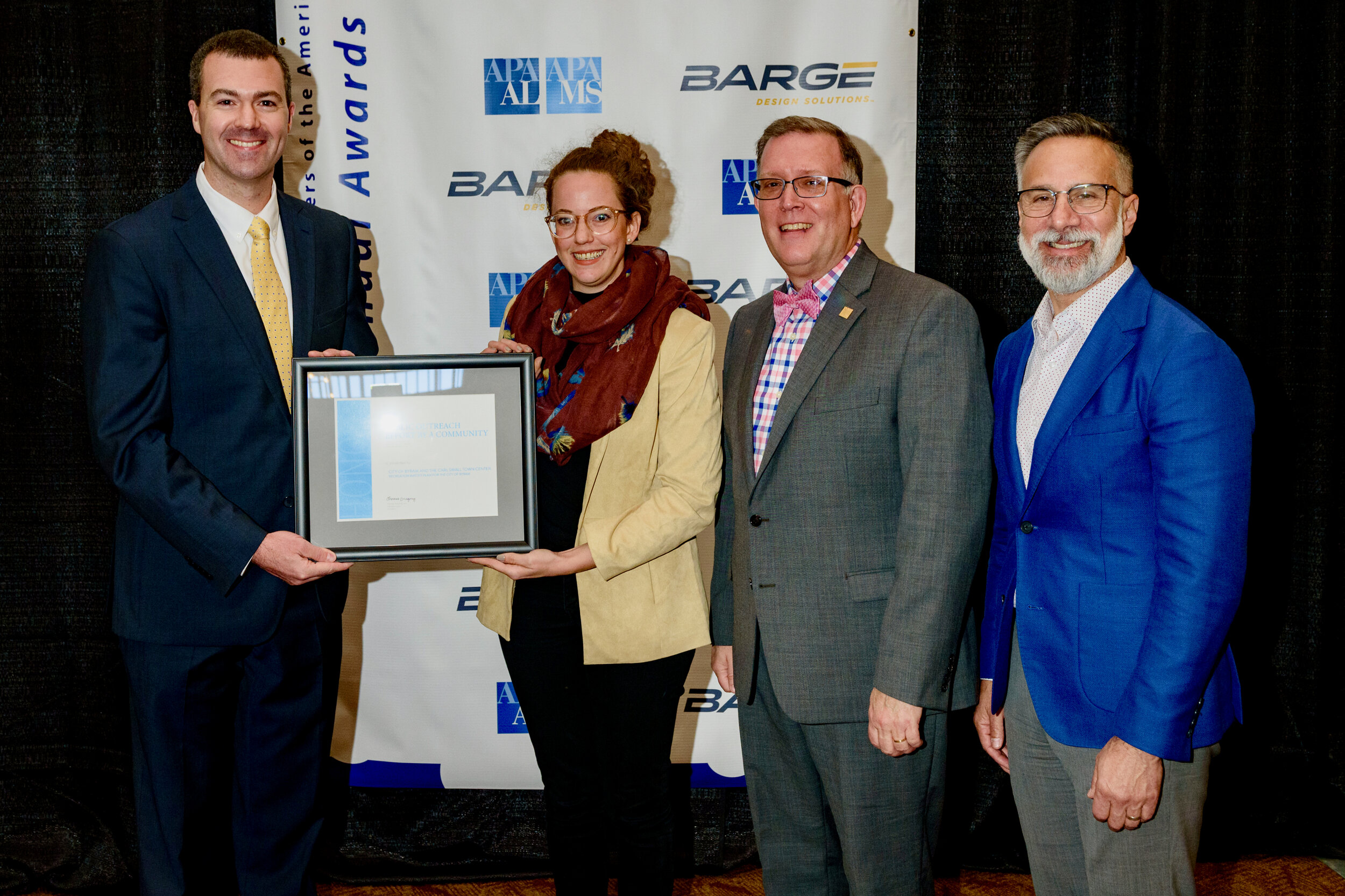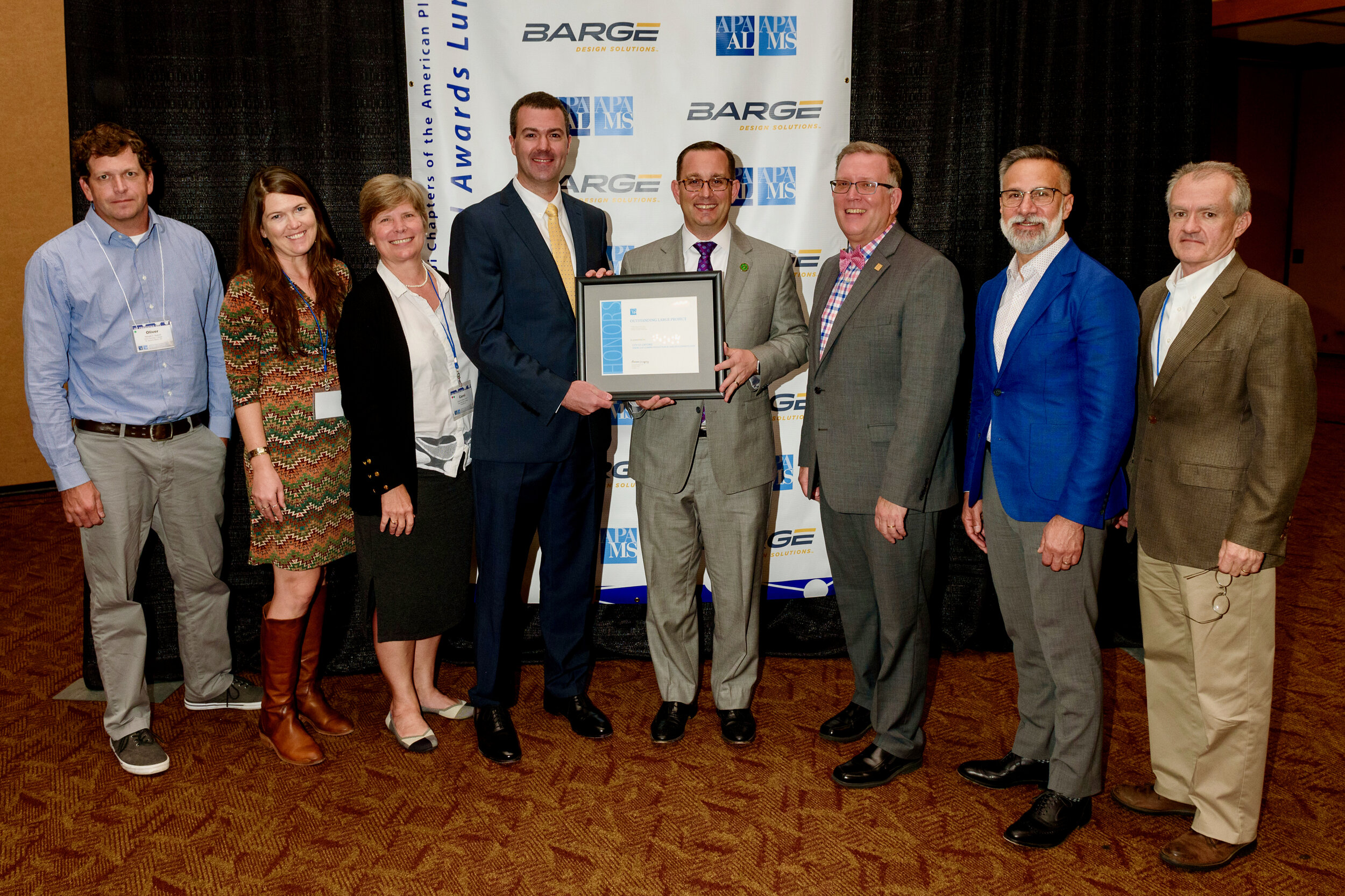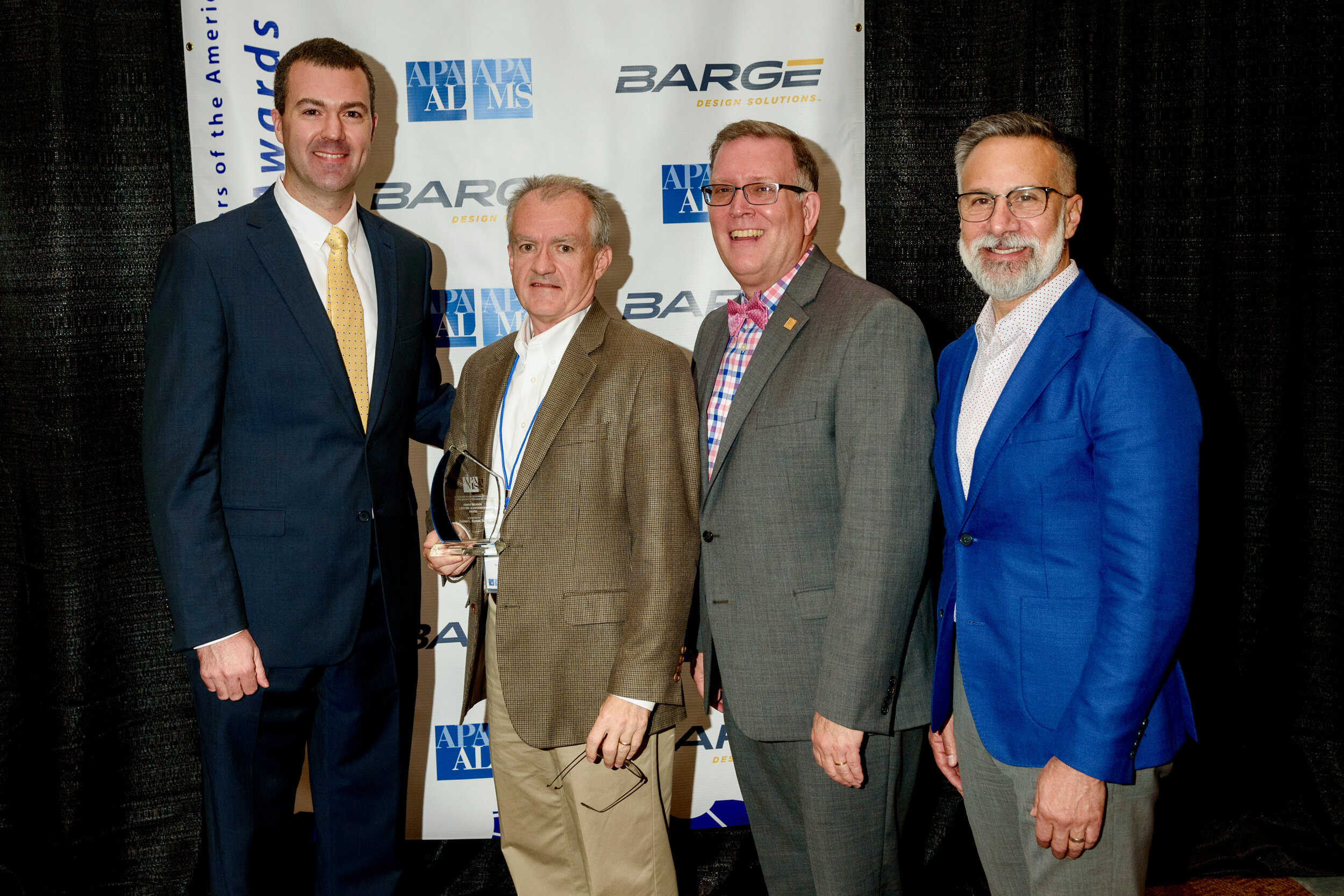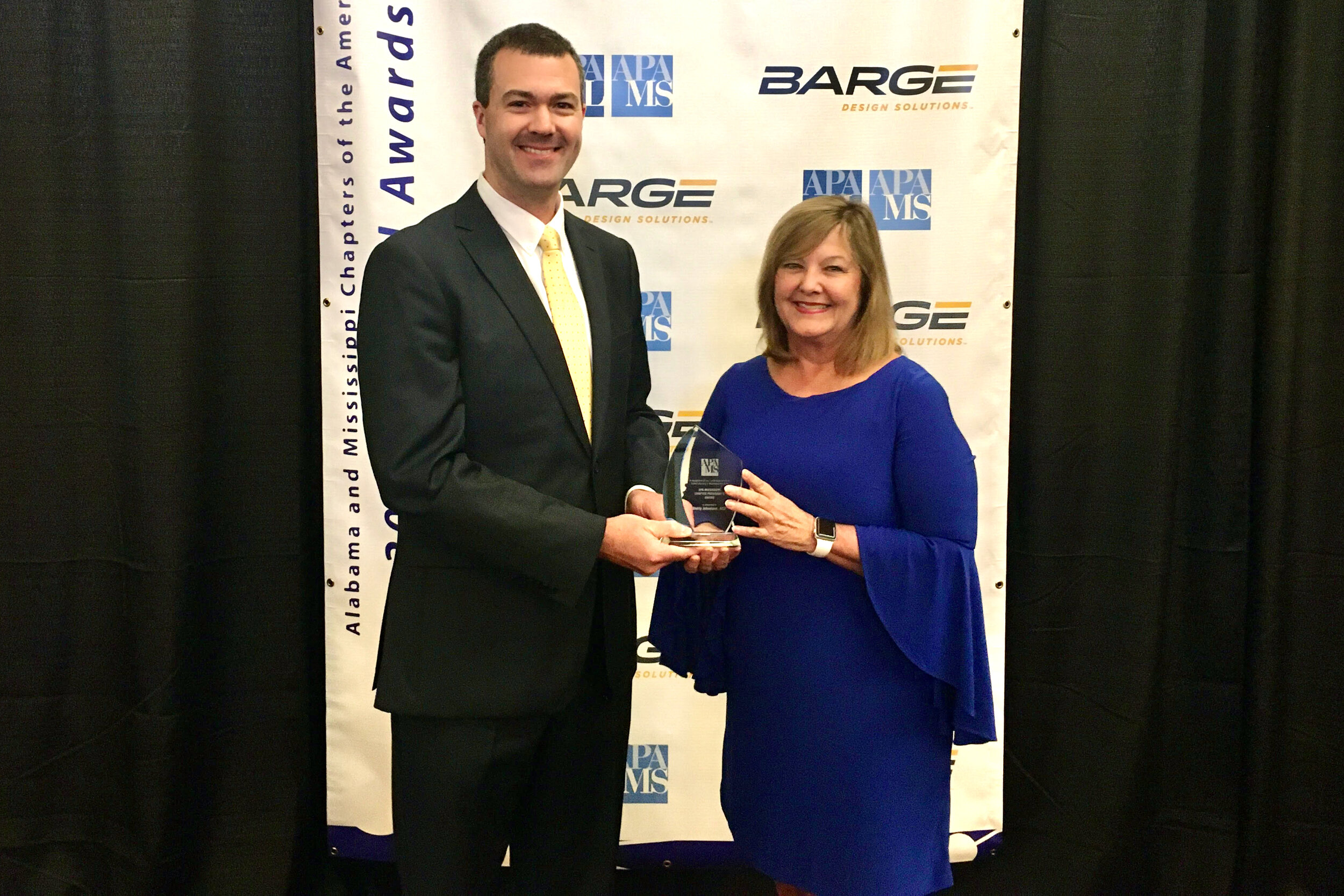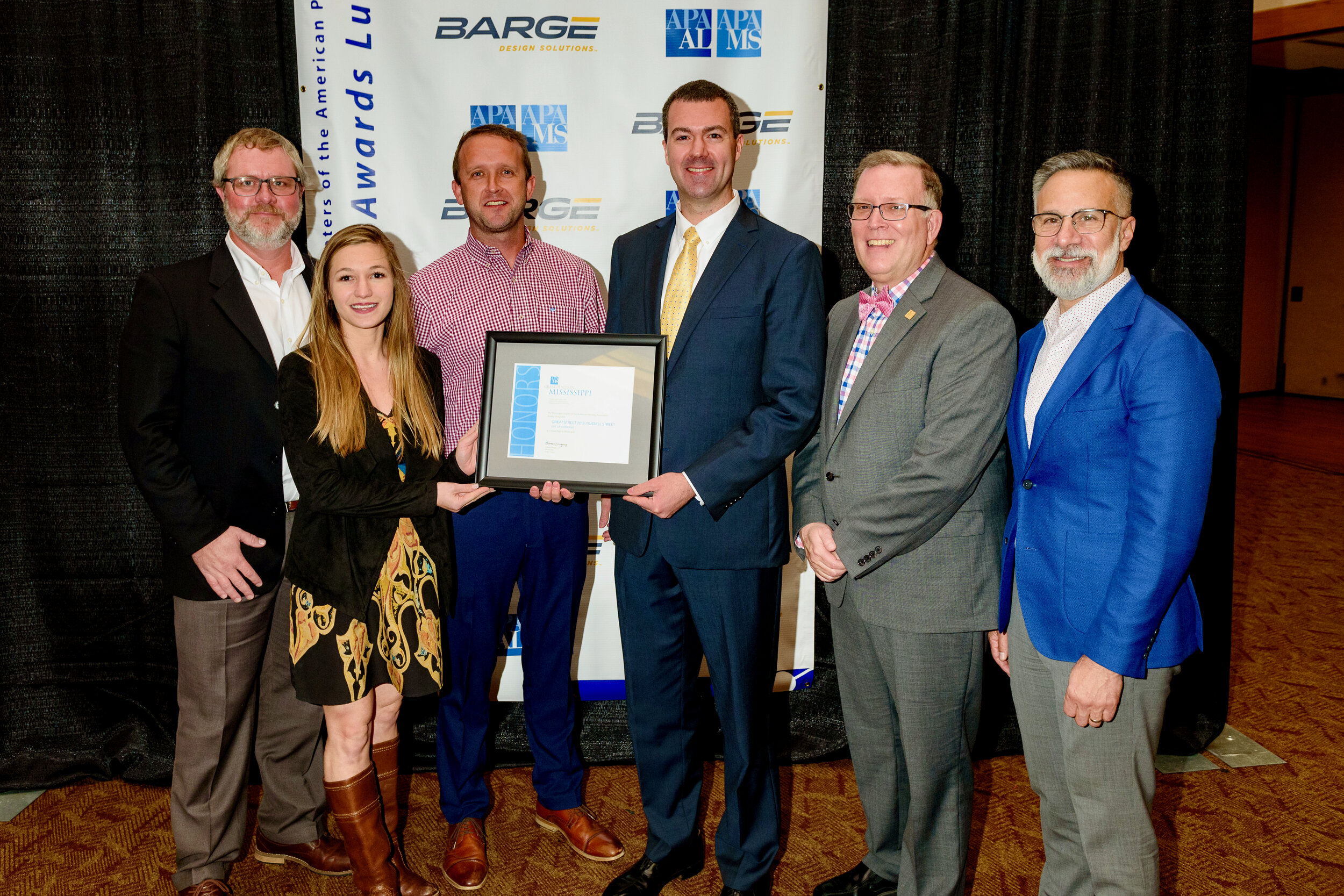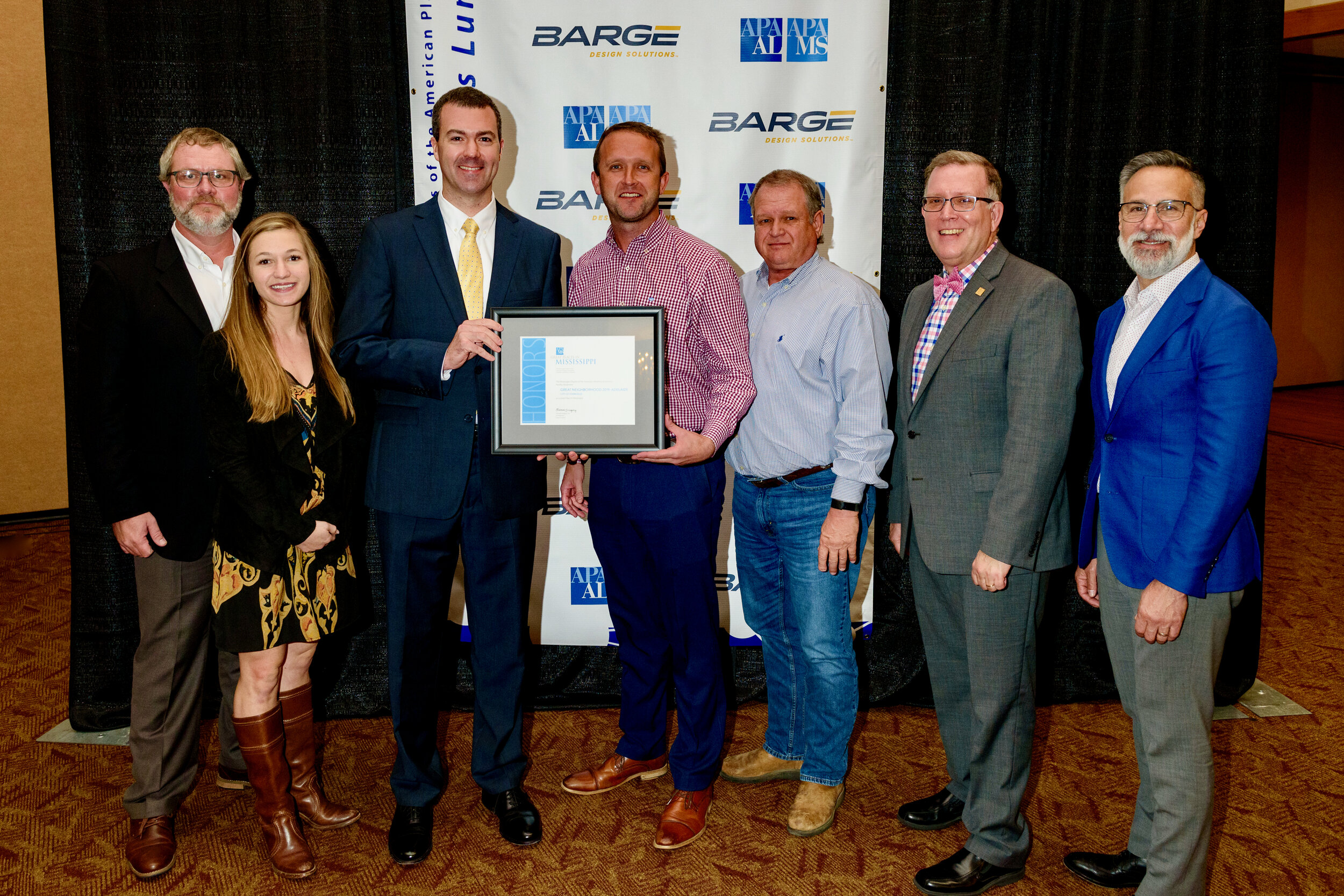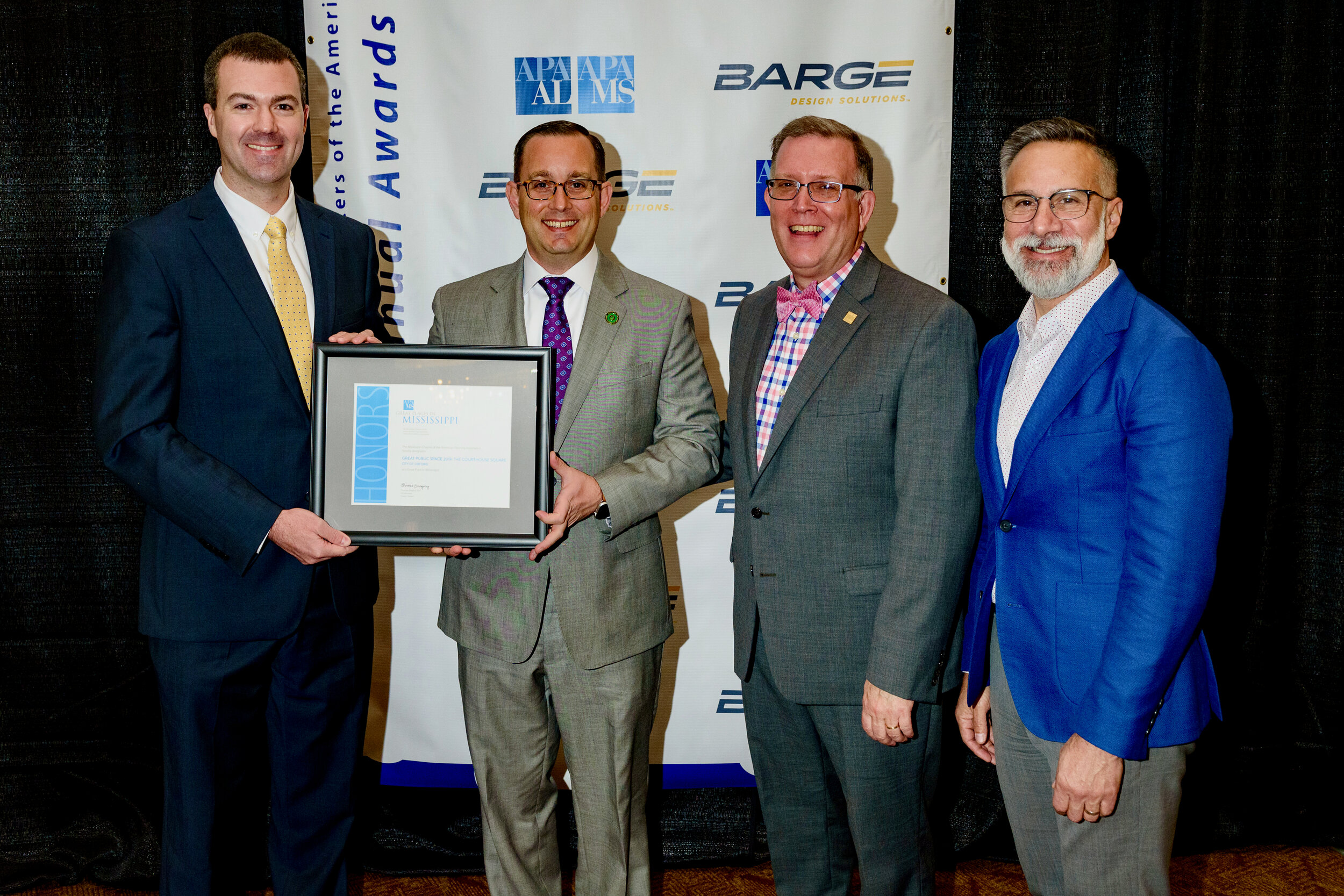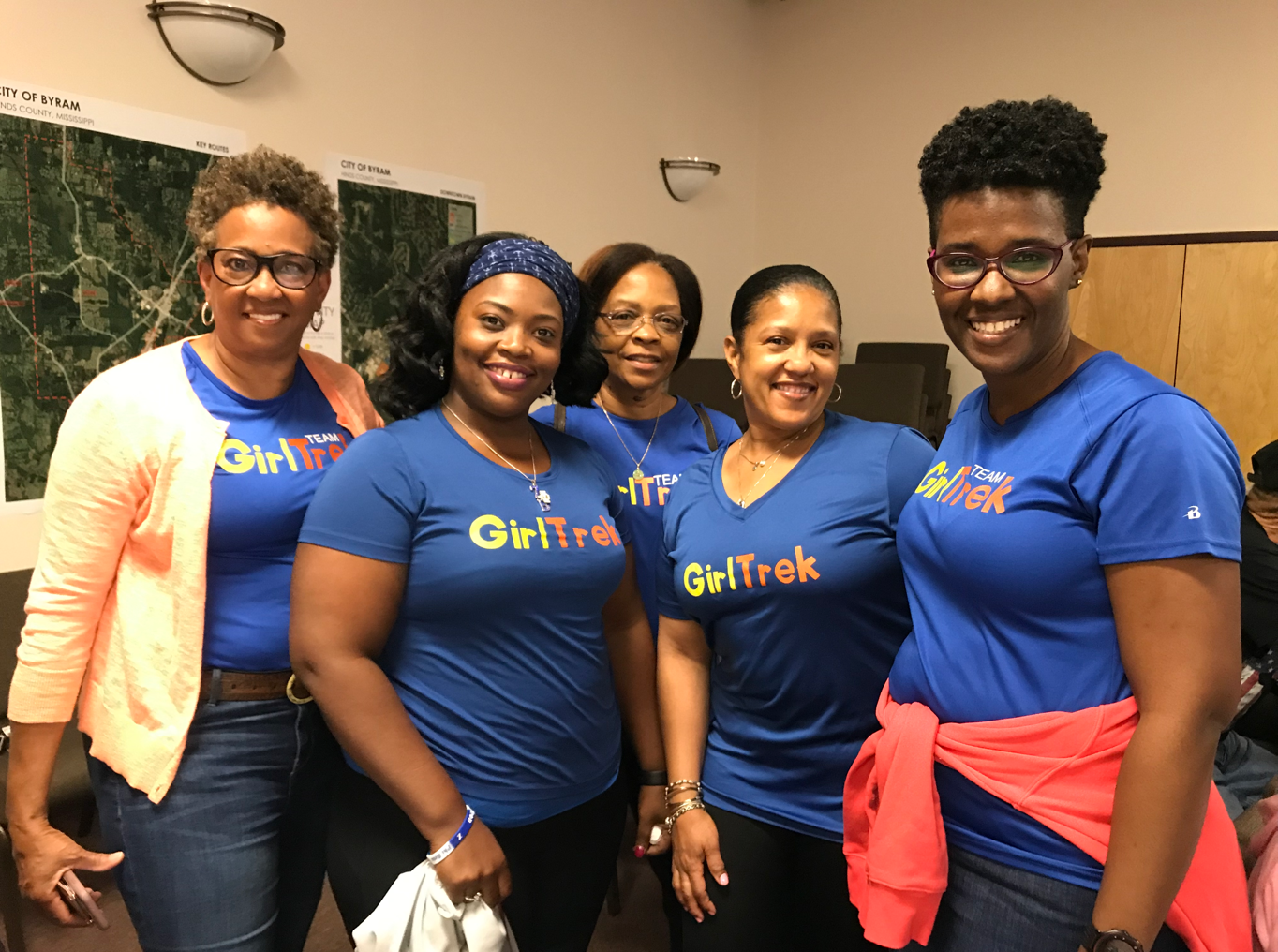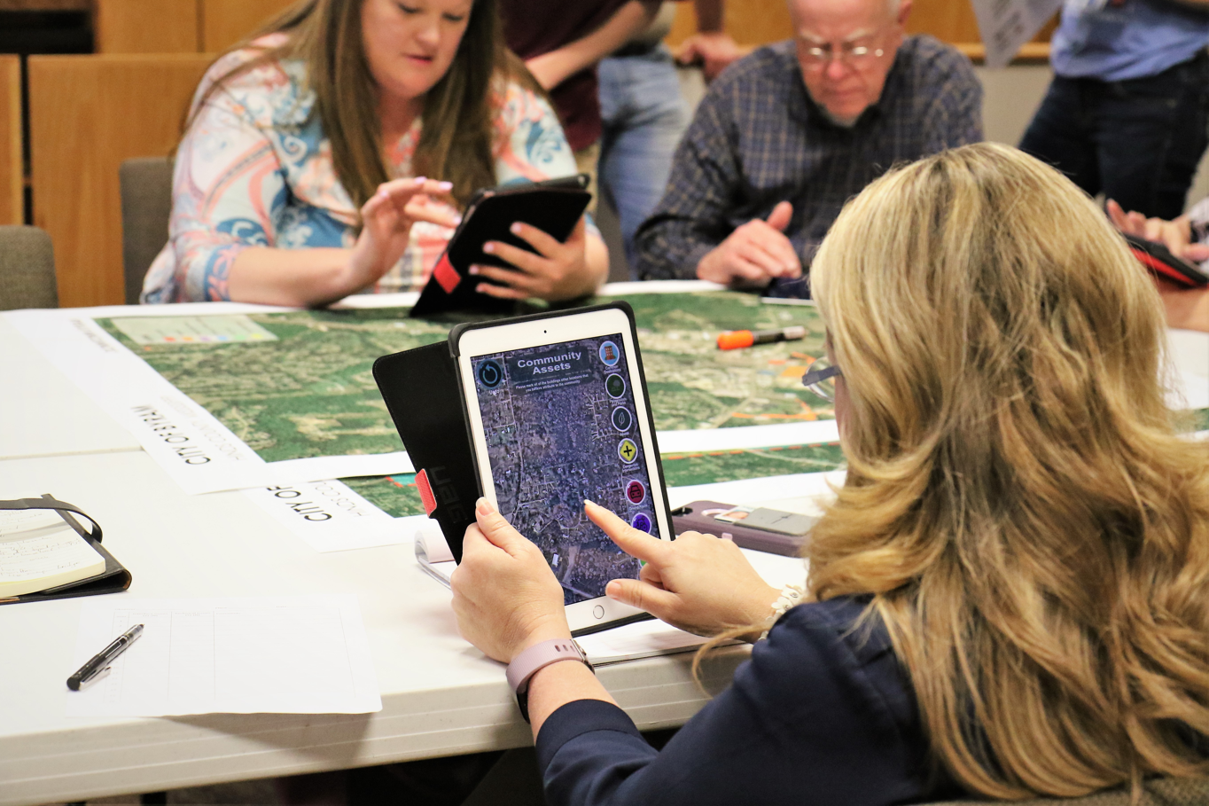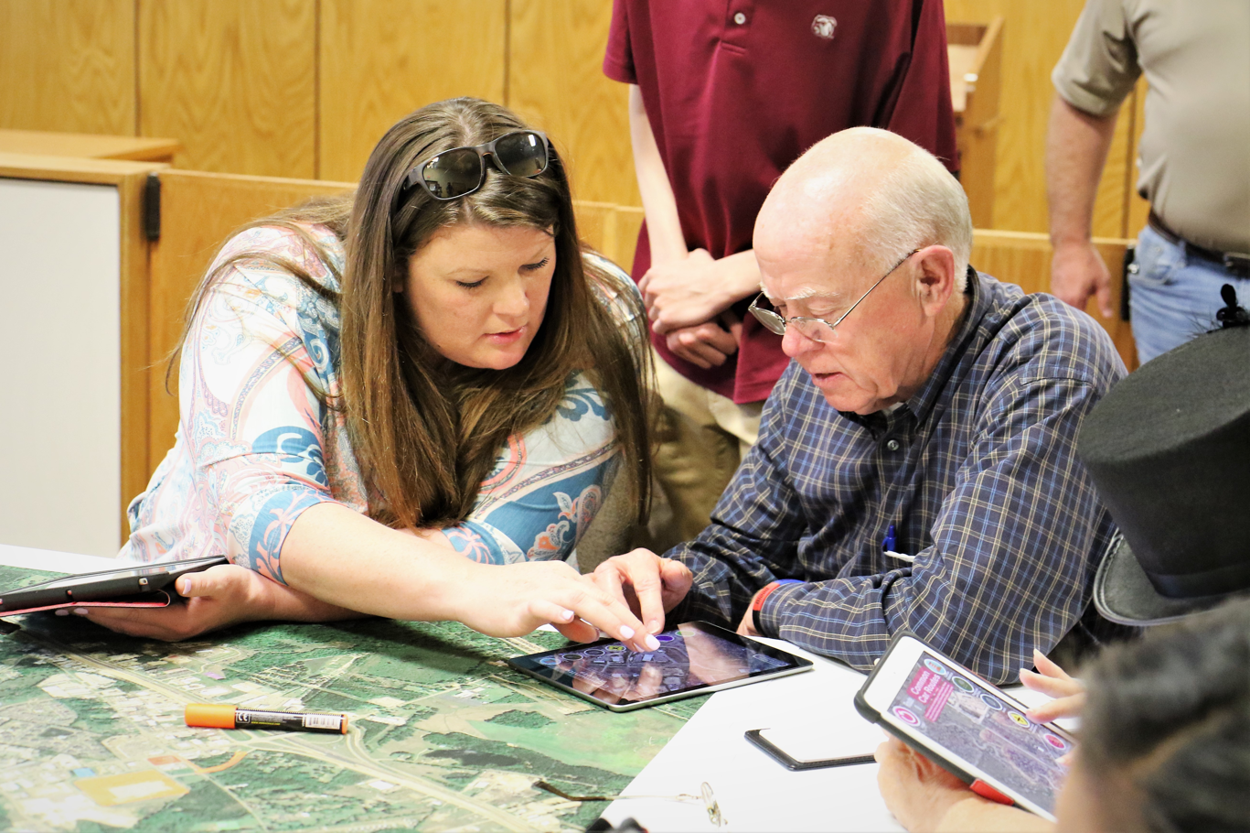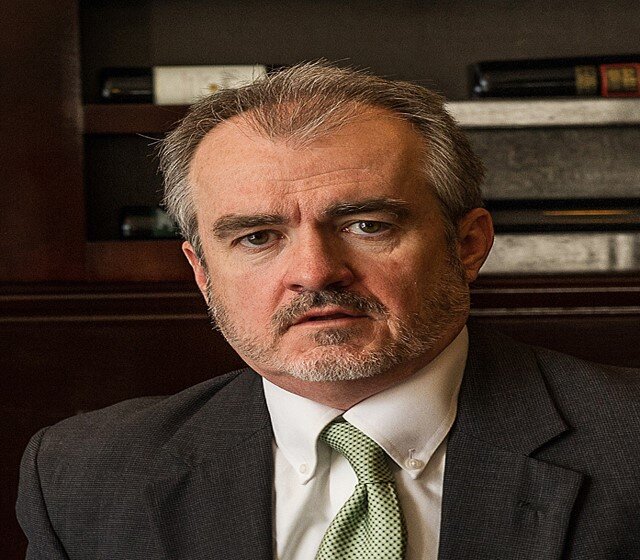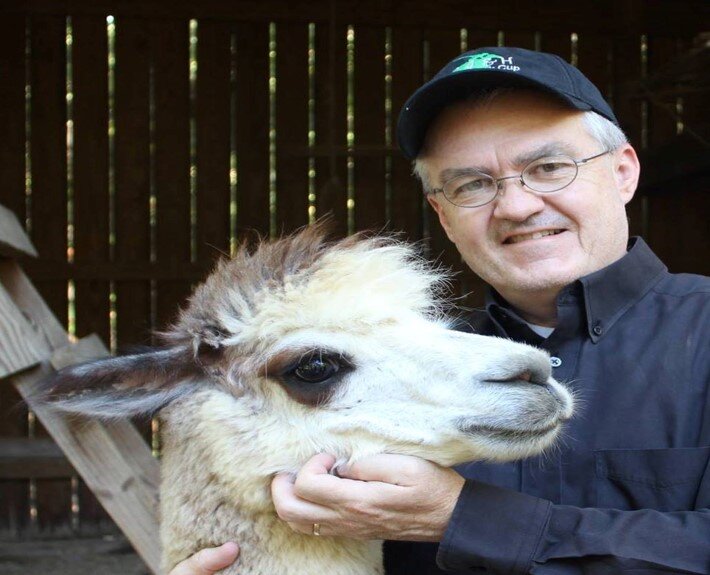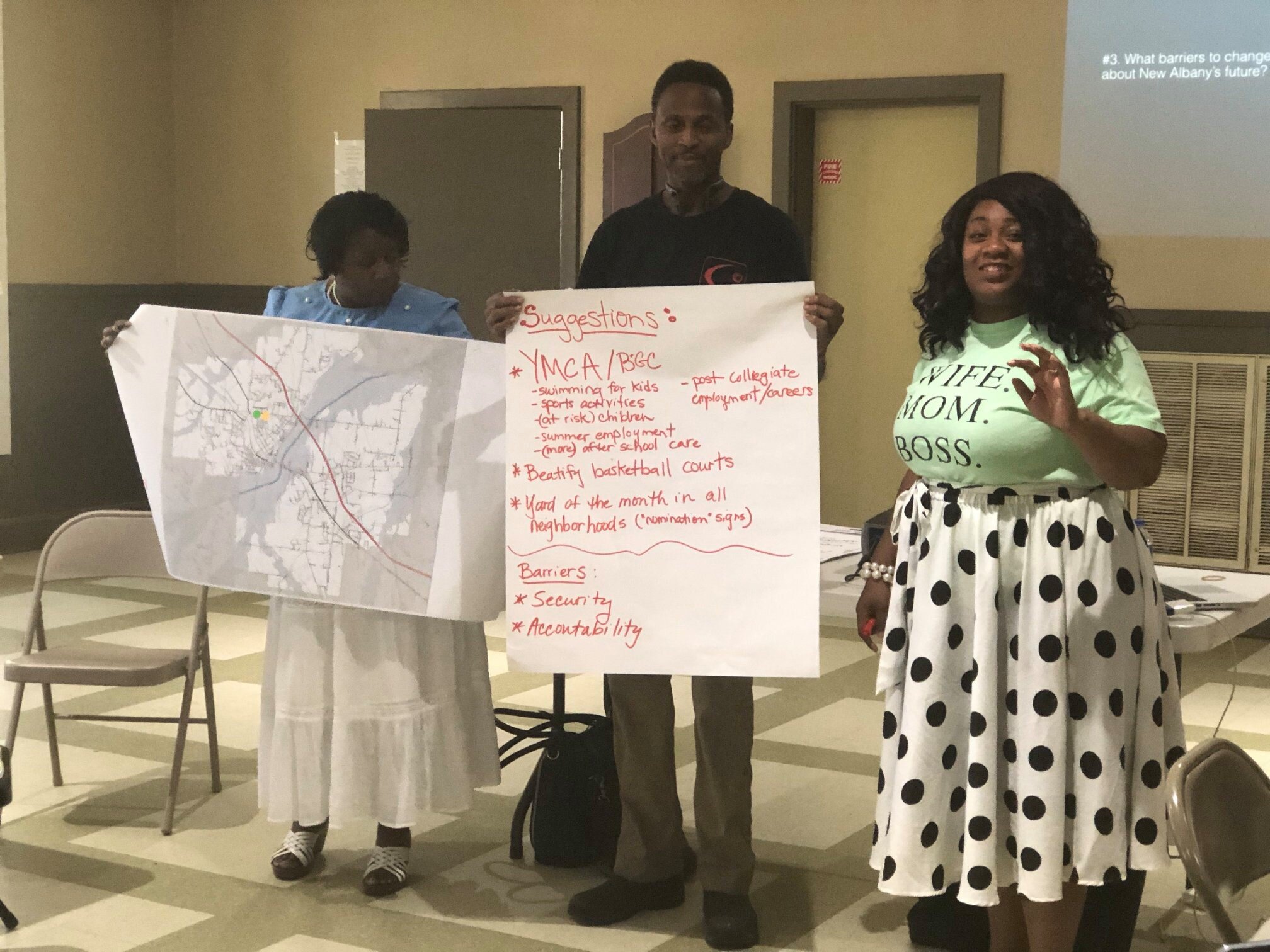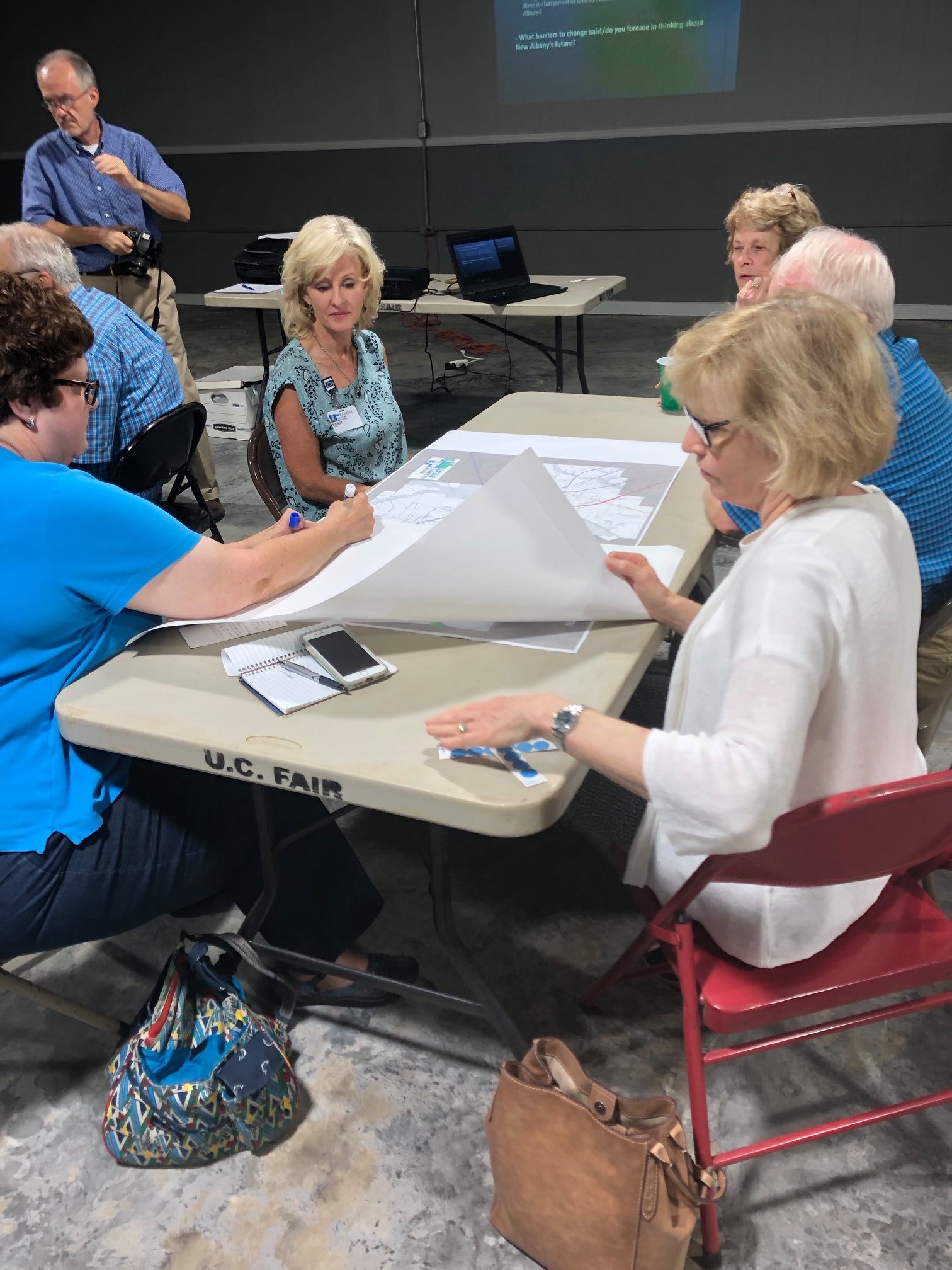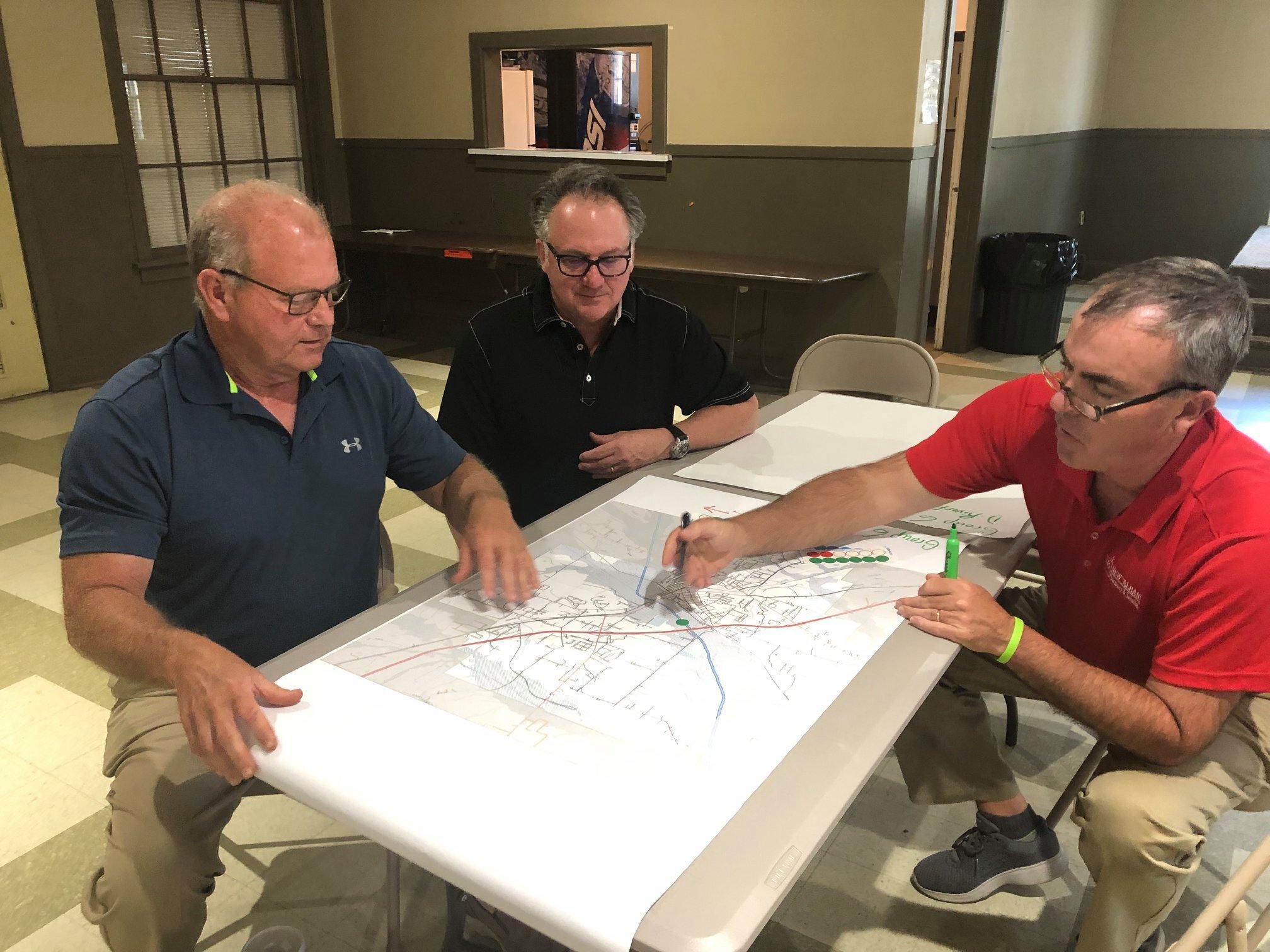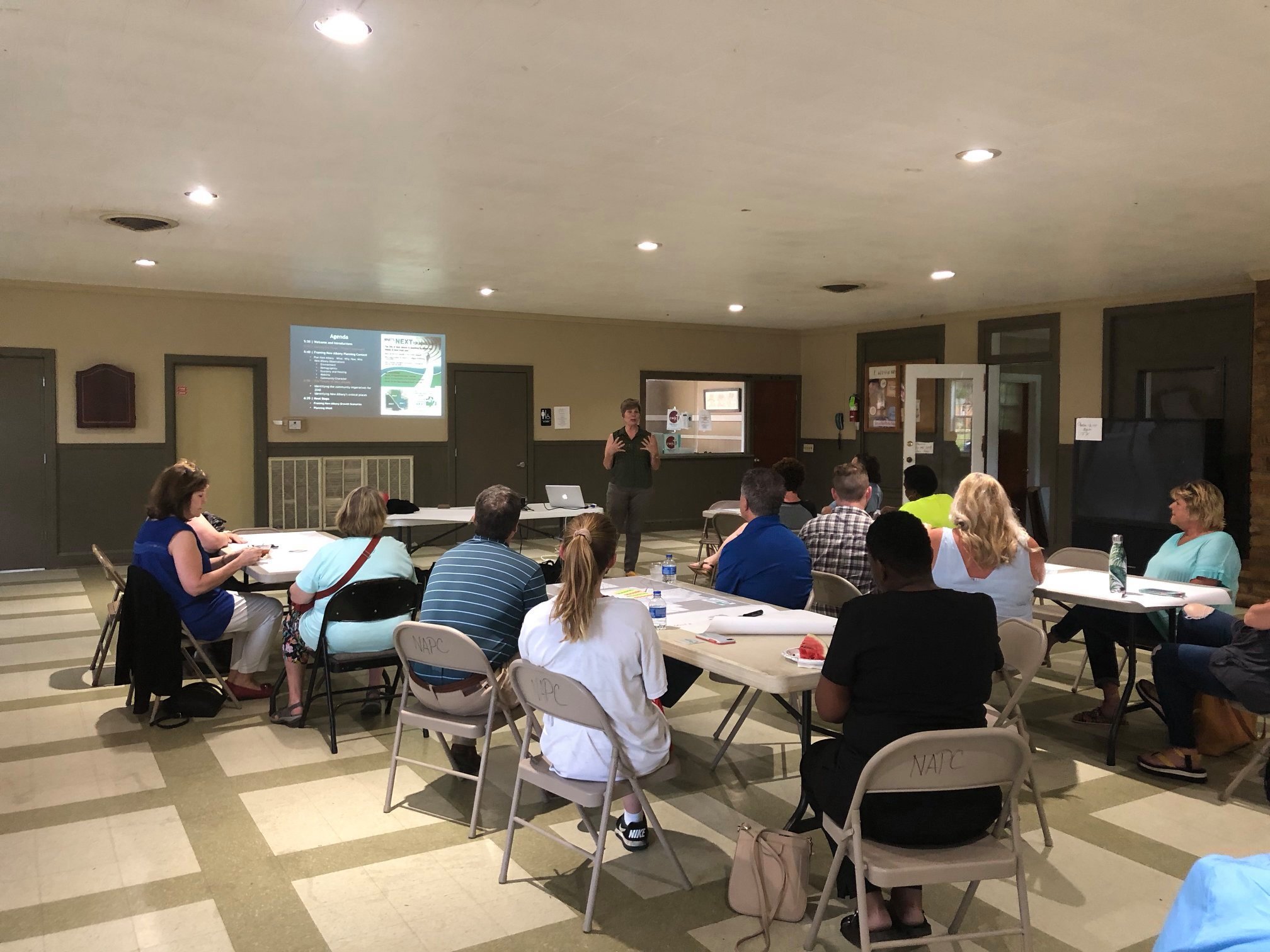2019 APA MISSISSIPPI AWARD WINNERS
The American Planning Association Mississippi Chapter (APA Mississippi) honors innovative planning efforts and inspiring individuals with its 2019 Annual Awards. APA Mississippi’s awards program is a proud tradition established to recognize outstanding community plans, planning programs and initiatives, public education efforts, and individuals for their leadership on planning issues. These efforts help create communities of lasting value throughout the state. APA Mississippi presents awards for achievement in several areas of planning each year.
The Mississippi Chapter of the American Planning Association also started the Great Places in Mississippi program in 2019 to recognize the great neighborhoods, streets, and public spaces that are found in communities across the state.
These awards are selected through a juried process and were awarded at the October 18th, 2019 Annual Alabama/Mississippi Joint Conference Awards Luncheon.
APA Mississippi’s 2019 Chapter Awards winners are:
• Best Public Outreach – The Byram Recreational Master Plan outreach effort. Presented to the Carl Small Town Center at Mississippi State University. The award celebrates the successful use of special designed software used on I-Pads to reach a very broad spectrum of the community as a tool for creating this Recreational Master Plan.
• Best Large Project in a Community of Over 15,000 – Vision 2037 Comprehensive Plan and Land Development Code for Oxford. Presented to the City of Oxford and consultants Orion Planning + Design, this award celebrates the creation of a Comprehensive Plan and new Land Development Codes that reflect new directions for the City of Oxford to protect and enhance the best of the past, while allowing and encouraging growth following a path of creating places, not just buildings.
• Randy Meador Lifetime Achievement Award – Presented to Bob Barber, FAICP, Orion Planning + Design. Mr. Barber has contributed to the profession and to the Chapter generously for well over 30 years. Both as a public servant and as a consultant, he has been a leader and teacher for many throughout the state.
• President’s Award – Shelly Johnstone, AICP, Johnstone and Associates. Ms. Johnstone is a planning consultant and worked for the City of Hernando as the Deputy Planning Director and Community Development Director for many years. The President’s Award recognizes her role as a mentor for young planners in Mississippi.
2019 Great Places in Mississippi inaugural winners are:
• Great Street – Russell Street Improvement Project in Starkville. Presented to the City of Starkville and Neel-Schaffer. The award is for a project that greatly improved the walkability and visual character of this important corridor linking downtown Starkville to the campus of Mississippi State University.
• Great Neighborhood – Adelaide Neighborhood in Starkville. Presented to the City of Starkville and Saunders and Sandy Ramsey of Adeliade Living, LLC. The award celebrates a relatively new neighborhood, still under construction, built under the precepts of a Traditional Neighborhood Development.
• Great Public Space – The Square in Oxford. Presented to the City of Oxford. The award celebrates the historic downtown Square in Oxford, long the center of culture and economy in this city, with an enduring and special sense of place.
Best Public Outreach – The Byram Recreational Master Plan outreach effort by the Carl Small Town Center at Mississippi State University
The Public Outreach Award recognizes an individual or program that uses information and education to raise awareness about the value of planning. The award was presented to the Carl Small Town Center at Mississippi State University, for the outreach effort for the Recreation Master Plan for Byram, Mississippi.
In April 2019, the City of Byram, MS, a bedroom community of the state’s capital of Jackson, MS, hired the Carl Small Town Center to create a recreation master plan for the 11,000+ resident community. Largely comprised of suburban development along a busy interstate corridor with no downtown core, this newly incorporated community was desperate for pedestrian and other recreational opportunities.
In partnership with MSU’s Center for Advanced Vehicular Systems (CAVS), the CSTC developed new software to facilitate more interactive community engagement and more accurate feedback to inform the master plan. The software was tailored to get feedback on community assets, frequently visited places, location of existing park and recreation facilities, current and desired pedestrian paths, current and desired bike routes, driving routes, and dangerous intersections. The process of engagement used allowed all sectors of the community to provide input into the master plan. The purpose of using the new software and iPads was to ensure individual input was captured from all ages, races, and demographics. Often in the engagement process, all voices are not able to be heard and specific information, like desired walking routes, would not be possible to obtain as quickly and accurately through a traditional planning process. The use of new technology and iPads allowed residents to try something different, yet familiar, which made the planning process more enjoyable.
The CSTC partnership with the City of Byram and incorporation of data into the planning process provided a level of trust of the planners involved, as well as assurance of their recommendations made in the master plan. Ultimately, leaders and residents had fewer doubts and questions about the recommendations because the data was readily available and clearly drove the final design of the master plan.
Best Large Project in a Community of Over 15,000 – Vision 2037 Comprehensive Plan and Land Development Code for Oxford.
Presented to the City of Oxford and consultants Orion Planning + Design, this award celebrates the creation of a Comprehensive Plan and new Land Development Codes that reflect new directions for the City of Oxford to protect and enhance the best of the past, while allowing and encouraging growth following a path of creating places, not just buildings.
The City of Oxford has had comprehensive plans since 1962, with the most recent adopted in 2004 after an extensive civic engagement effort from 1999, called Vision 2020. Oxford later experienced a tremendous growth period from resulting in a call in 2014 for a new Master Plan that protected the character and quality of life in Oxford. The Mayor and Board of Alderman also recognized that need, but also wanted to ensure the implementation of what was adopted, so they made the investment to hire a consultant to update the Comprehensive Plan and the Land Development Code.
City leaders selected Orion Planning + Design as the lead consulting firm to lead the effort. Community meetings began in early 2015, and after multiple meetings, consultations between staff, city leaders, and the consultants, and a planning charrette, Vision 2037 was adopted in 2016. This plan was formed from community input, Oxford’s Guiding Principles for the future, and from Smart Growth principles.
Work began immediately after the Master Plan was adopted to align Oxford’s Land Development Code to Vision 2037. The revised code was an almost total reorientation of Oxford’s land regulation tools from a means that created dominant suburban forms, to the regulatory tools needed to ensure compact, walkable, traditional urban forms. The Plan envisioned ways to avoid impending destructive sprawl development; so the code took a very new approach, designed to lead to mixed-use commercial centers and mixed-dwelling neighborhoods; segmented by intensity of development rather than types of uses.
The Vision 2037 Comprehensive Plan and Land Development Code represent time-tested principles of Smart Growth and Place Making now embedded in Oxford’s regulatory framework. These documents are guided by a planning continuum of place types rather than a conventional use-based planning model. The consultants worked closely with staff and city leaders to create this more visual and place – rather than use – based format. The efforts of the City Leaders, through the guidance of Orion Planning + Design have set a new path for the City of Oxford. This path better reflects city values of respecting our small town heritage, and building on the best of our “sense of place” by ensuring that future growth will reflect those values, rather than the banality of sprawling suburia.
Randy Meador Overachiever Award – Bob Barber, FAICP
The Randy Meador Overarchiever Award was presented to Bob Barber, FAICP. Bob is a Mississippi native son who has devoted most of his career to working for communities in the state, and to being a leader of and good friend to the Mississippi APA Chapter. After being one of the last graduates of the graduate school of URP at Ole Miss, he worked in northwest Mississippi for almost 25 years. During those years, he became a leader of the Chapter, and a leader of national APA, serving in various elected and appointed roles.
Bob began a new career as a consultant in 2011, working around the state and around the country as one of the founders of Orion Planning + Design. In that capacity he became an even better friend to the Chapter, providing advice and guidance to Chapter leaders, and becoming, through Orion, a major sponsor of Chapter conferences. (A godsend to Conference planners.) His mentoring advice, related to Chapter issues or professional conundrums, has helped a generation (or two) of younger planners as they have assumed leadership positions.
His national service has continued as well. In recent years he served as Chair of the AICP College of Fellows (two terms) and Chair of the AICP Ethics Committee. He is currently on the APA Education Committee, is still a member of the AICP Ethics Committee, and is now Chair of the APA Futureshape Research Agenda Plans and Plan Making Workgroup.
Bob’s work in large and small Mississippi places has included well over 50 communities in all segments of the state. He has been a true teacher of good planning principles in Mississippi to local government, and to other planners through his numerous presentations at conferences and seminars, and to graduate students.
Aside from his technical knowledge, his personal demeanor is a key to Bob’s success. His respectful manner of approach to community leaders, regardless of their level of understanding of planning principles, has meant that he has built relationships of trust. That allowed him to see plans and ordinances adopted that have a good potential for being implemented and upheld, not just shelved because they are too sophisticated or complicated for a community just starting baby steps toward land use regulations. When more sophisticated tools are desired, he is abreast of cutting edge tools and approaches, and knows how to explain how they work to lay citizens without using “plannereze”.
Knowledge of, and use of, urban planning tools and techniques has expanded within Mississippi thanks to Bob’s approach and knowledge. Our chapter has in him an invaluable mentor and supporter. Bob Barber deserves this appreciation of his professional colleagues who know him well as a consummate wise and intelligent professional, a courteous and soft-spoken gentleman, and a good friend.
President’s Award – Shelly Johnstone, AICP, Johnstone and Associates
The President’s Award is presented by the Chapter President to recognize exemplary, sustained service to the Chapter. Shelly Johnstone, AICP, of Johnstone and Associates, was this years recipient.
Shelly has been a practicing city planner, community developer, and marketer for over 40 years. She graduated from the University of Mississippi with a Bachelor's Degree in Public Administration as well as a Master's Degree in Urban and Regional Planning. Ms. Johnstone is a certified planner with the American Institute of Certified Planners, and a charter member of the American Planning Association. She has served as an officer in the Mississippi Chapter of the American Planning Association, and been selected for participation in national, state, regional and local leadership programs. Ms. Johnstone is the President of the Board of the North Mississippi Land Trust, and a board member for the Mississippi Sustainable Agriculture Network and the Mississippi Food Policy Council.
Shelly was most recently the Director of Community Development for the City of Hernando and is the founder of the award-winning Hernando Farmers Market. Her previous roles have included working as the Planning Director for Three Rivers Planning and Development District, the Executive Director of the Pontotoc Chamber of Commerce, and the Director of Marketing and Development for North Mississippi Health Services among others.
Shelly Johnstone, AICP
Ms. Johnstone is a planning consultant and worked for the City of Hernando as the Deputy Planning Director and Community Development Director for many years. The President’s Award recognizes her role as a mentor for young planners in Mississippi.
Great Street – Russell Street Improvement Project in Starkville
The award is for a project that greatly improved the walkability and visual character of this important corridor linking downtown Starkville to the campus of Mississippi State University.
Russell Street is a three-quarter mile corridor that links the campus of Mississippi State University to downtown Starkville. Prior to 2016, the corridor was a four-lane street with strip style development that lacked adequate pedestrian amenities and development. In 2011 a study was commissioned by Appalachian Regional Commission-Mississippi Main Street Association to conduct a community planning and economic development charrette for Starkville. This master plan showing the Russell Street Corridor was one of the outcomes from the charrette process.
After the charrette was completed, the city began implementing key recommendations identified such as the adoption of form-based codes and adding historic preservation districts. While the city embraced the Russell Street redevelopment vision, a few years would pass before the momentum was strong enough to undertake the redevelopment of the Corridor. The biggest hurdle the city faced was finding funding for the project. Finally, in 2015 MSU received a Federal Highway Administration grant, administered through MDOT to implement the Russell Street redevelopment plan. This funding covered 80% of the grant, with the other 20% being covered by a partnership between the City and Mississippi State University.
Work on the corridor began in late 2016. The four-lane road was reconfigured into two lanes and added a turning lane. By reducing the lane width, two five-foot bike lanes, on-street parking, and sidewalks were added. Additionally, five landscape islands planted with large trees and shrubs were strategically placed near intersections and throughout the corridor, providing crosswalks and pedestrian refuge spaces. A new pedestrian connection from Russell Street to the University Drive Pedestrian Bridge was also created. The new sidewalk connected existing sidewalks on Russell Street to those existing on University Drive. New pavement markings were provided for crosswalks, bicycle lanes, and vehicular travel lanes. Nearly 100 new canopy trees were planted throughout the corridor as well. The Russell Street Boulevard opened the 2017 just before the start of the MSU football season, enticing residences to walk toward the campus and alumni and visitors to walk downtown.
This project also served as a catalyst for other improvements along the corridor including the edition of new mixed-use developments that feature pedestrian-scaled exterior amenities and public art in the form of murals. In the summer of 2019, a new festival event was created for this area. The Greater Starkville Development Partnership held the first annual “Bud and Burgers” event. The successful implementation of an innovative plan has transformed a highly visible blighted area into one of the most active and desirable places in Starkville, Mississippi’s College Town.

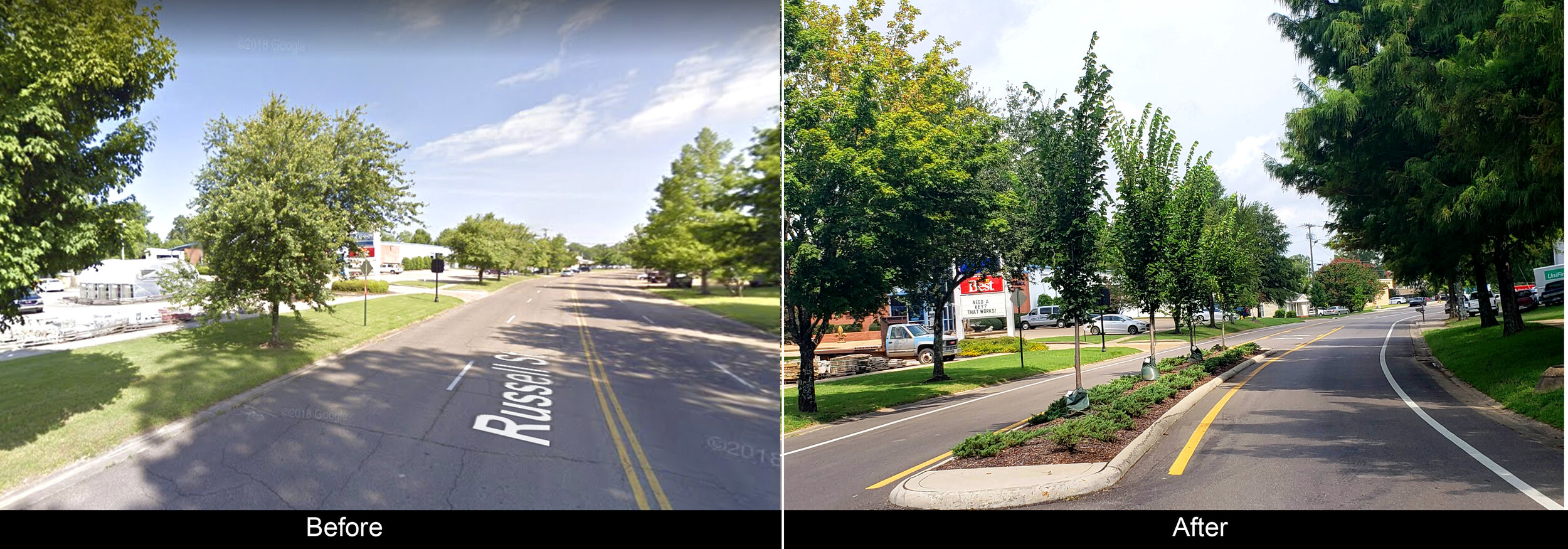
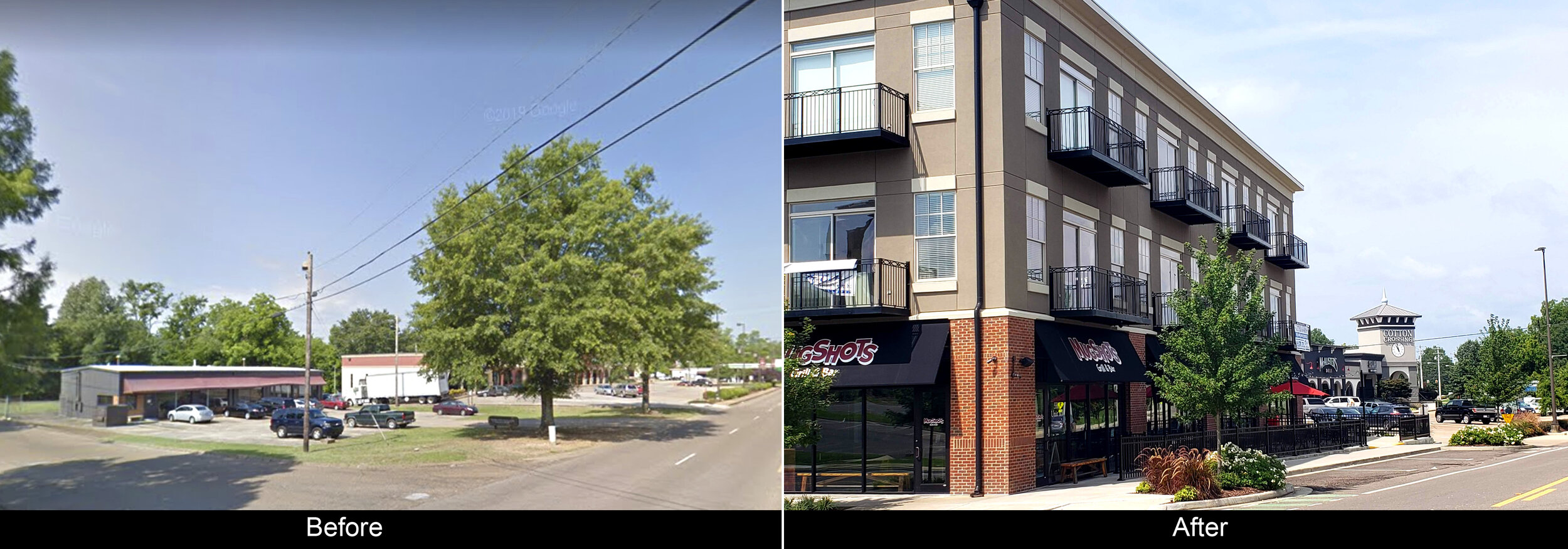
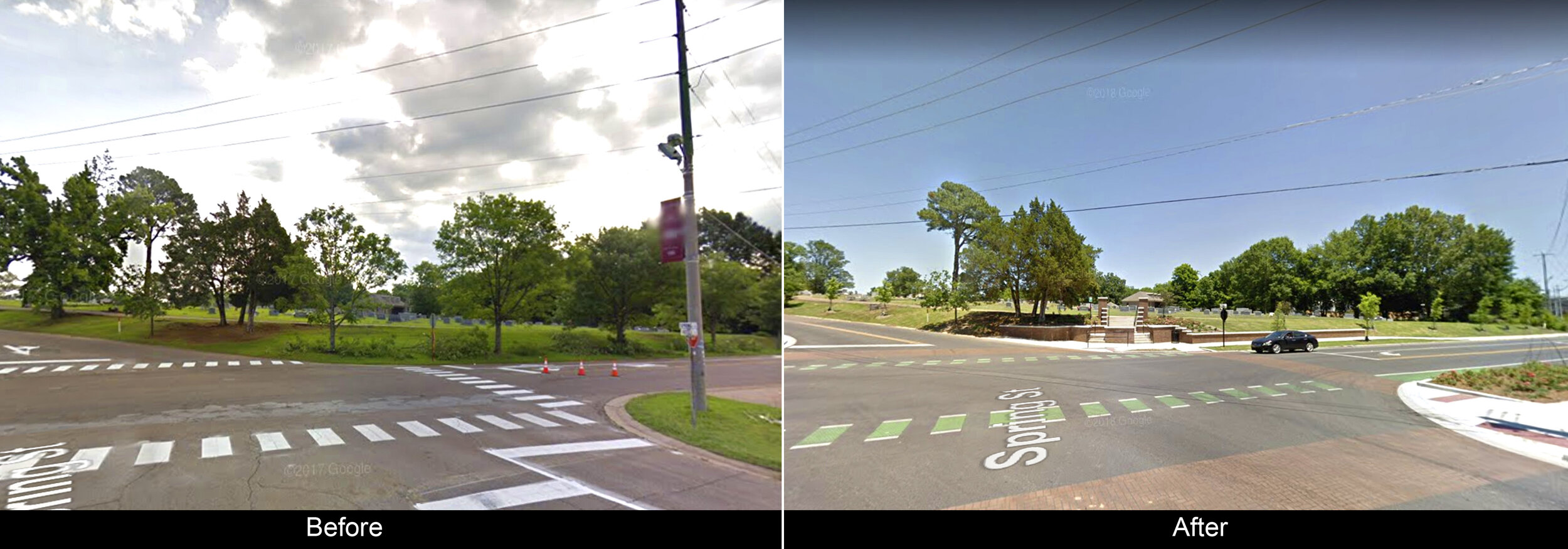
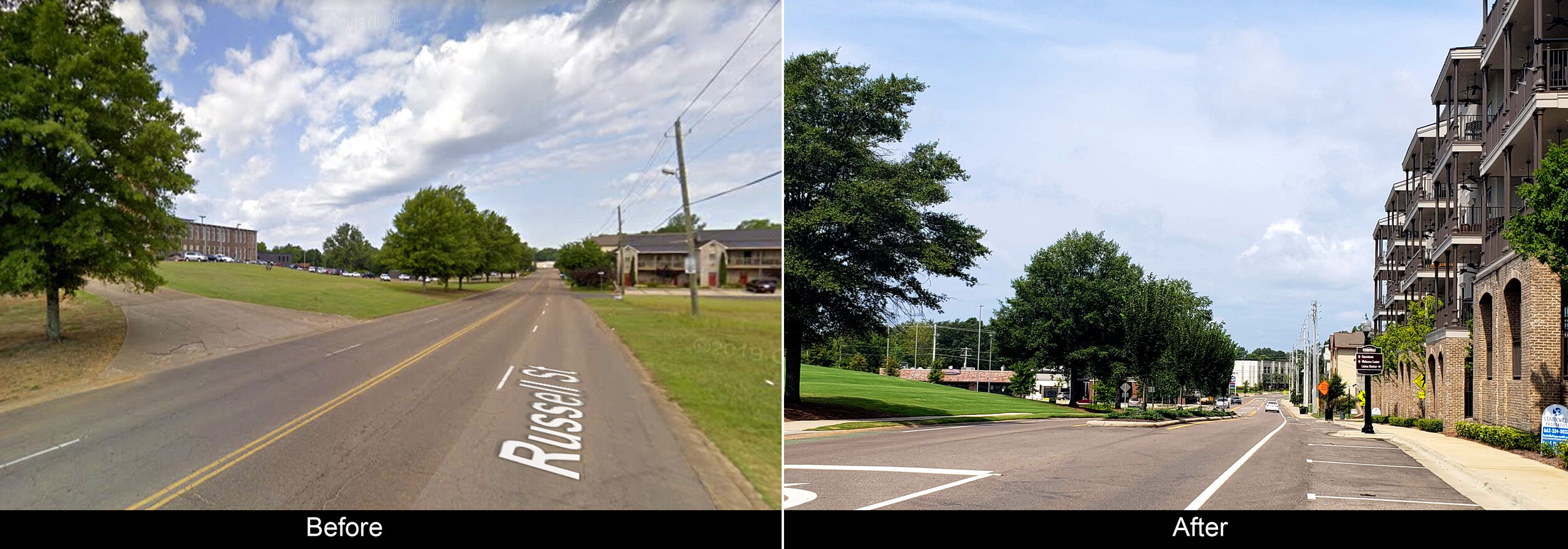
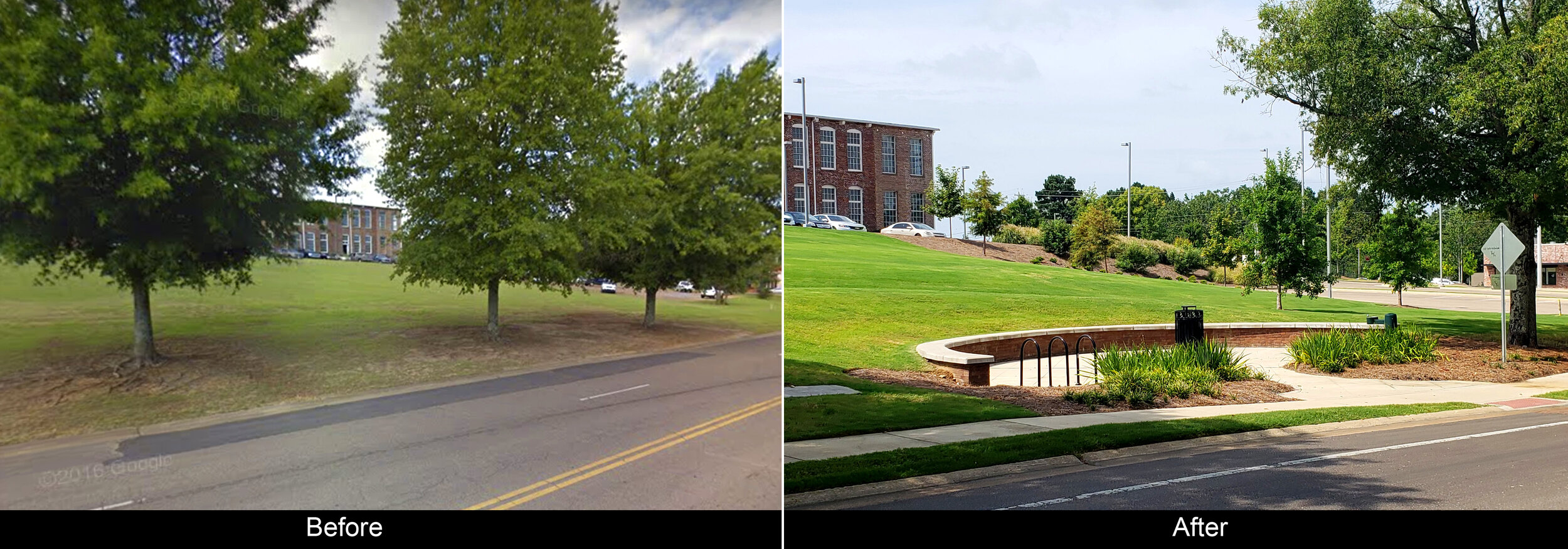
Great Neighborhood – Adelaide Neighborhood in Starkville
The award celebrates a relatively new neighborhood, still under construction, built under the precepts of a Traditional Neighborhood Development.
Adelaide is a new Traditional Neighborhood Development located on the south side of Starkville, MS. The site has rolling topography with picturesque open space surrounded by mature trees. The agricultural character and history of the property is evident by the existing ponds, pastures, and barn structures.
The planning story of Adelaide is the product of a family's dream to create a place that would honor their family’s history and add to the quality of life of their community. This dream began as a shared vision of a father and son. The father, Sandy Ramsey, with a background in real estate and the son, Saunders Ramsey, a civil engineer and development consultant, wanted to create a development pattern that currently didn’t exist in the area. The style that they felt most drawn to through their travels were Traditional Neighborhood Developments. This style of development offered the sense of place that would not only improve the quality of life of their residents, but also honor the history of their family’s land. It would bring back a development pattern that was prominent in the area a century ago, but had long been abandoned for the modern subdivision. The development would seamlessly blend residential, commercial, and public spaces with a focus on walkability, beauty, tradition, and a sense of community. Adelaide is designed for connectivity with a picturesque town center, wide open walkways, tranquil parks, and the convenience of shops and restaurants just a short walk away.
Adelaide is uniquely designed to look and feel as if it naturally evolved over the course of the last century. The development seamlessly blends residential, commercial, and public spaces with a focus on walkability, beauty, tradition, and a sense of community. The master plan is made up of five neighborhood centers which are strategically located so that every lot is within a five-minute walk to a neighborhood center. The circles on the plan represent 1/4 mile and ½ mile walks from each neighborhood center. These circles are referred to as Pedestrian Sheds. The lot sizes decrease in size as they increase in proximity to the neighborhood center to create a series of denser cores surrounding public space. Houses are organized in small neighborhoods around common landscape features and civic spaces. These become centers for social and recreational activity.
In 2017 the first phase of Adelaide was platted and individual lot construction started. The first phase was sold out within eighteen months. In 2019, phase two was platted with 33 lots and additional public space that included a civic space. A post office was added to the civic space to serve the community and provide a focal point for phase one entrance. Within six months of platting phase two, twenty-four of the lots had sold. The success of Adelaide has demonstrated the desire of the community as a whole for the creation of places not just subdivisions.
Great Public Space – The Square in Oxford
The award celebrates the historic downtown Square in Oxford, long the center of culture and economy in this city, with an enduring and special sense of place.
The City of Oxford, Mississippi, county seat of Lafayette County, was incorporated in 1837 on fifty acres conveyed to the county by three area pioneers who had purchased the land from two Chickasaw Indians. The initial City plan is a classical grid pattern, with a central square with primary streets radiating off from that square. Since Oxford began to grow in the 1840’s The Square became and remains the cultural and economic hub of the City, even as its role in the economy of the city has evolved to a more mixed commercial and entertainment role.
The Square is the ‘soul’ of Oxford, offering a place for residents, students, and visitors to shop in the many stores and boutiques, including the South’s oldest department store and one of the nation’s premier independent book stores. On the Square people enjoy dining in the numerous restaurants (from casual to fine dining and imbibing); and enjoy multiple entertainment venues. These include the restored historic Lyric Theater where local, regional and even nationally recognized musicians perform regularly. Yet traditional businesses remain, along with the buildings housing City, County, and Federal governmental functions. Oxford is also known for being the home of Nobel Prize winning author William Faulkner which attracts hundreds to literary events each year. Meanwhile, a statue of William Faulkner considers this evolution of the Square from his bench in front of City Hall.
Every Spring for the past 25 years, the Courthouse Square has served as the host for the Double Decker Arts Festival which celebrates food, music and the arts. A brainchild of current Mayor Robyn Tannehill, this festival started with the bed of an old pickup truck as a stage for music, and a handful of art and food vendors. Today more than 60,000 people attend the two-day event that offers more than two hundred art and food vendors with a mix of both local and touring musicians on the stage.
The Square provides a livable built environment, and a vibrant, economically and culturally mixed-use center for a small city. Its structures represent the evolution of the City from 1836 to the present. This compact center promotes mixed forms of transportation including transit and bike-share. The Square has all the features of a place with interwoven equity, as it is used and loved by a wide diversity of area residents, college students, and visitors. The Square will continue to evolve over time, and the opportunities it offers for people to interact there will continue. That will always be its most important feature.

